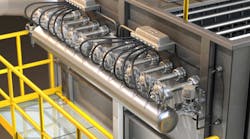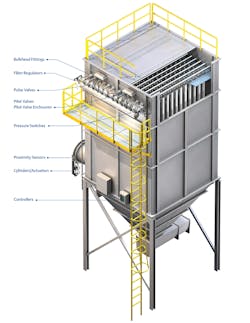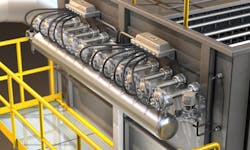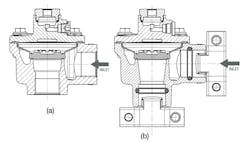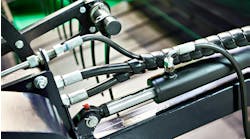In almost all industries, dust and particulates come with the job. But if they aren’t effectively removed or collected, these contaminants can harm workers and damage equipment. And when contaminants are combustible, facilities may not meet related NFPA regulations or pass OSHA inspections. From automotive to concrete and mining to pharmaceuticals and beyond, facilities depend on dust collectors to improve air quality for employees and machinery.
By providing clean air that is essential to a safe working environment, a dust collector’s performance and efficiency directly affect a facility’s overall efficiency. Because of this importance, OEMs and end-users constantly seek new ways to improve these systems. Specifying components with beneficial qualities and features makes a difference.
But which components can make the biggest impact? Let’s think about how dust collectors work.
As a dust collector operates, its filters catch dust. This accumulated dust forms a dense cake that can block filters and decrease system efficiency. In reverse pulse jet dust collectors, a reverse jet bag filter cleaning system delivers a burst of compressed air that sends a shockwave through the filters, breaking up dust cakes. The dust then falls out of the collector and into a hopper. By effectively clearing dust from filters, this system improves filter and overall system efficiency, and extends filter life.
In a practical example, most aggregate applications use a dust collection system to collect aggregate particulates produced from crushed limestone. The collected particulates are then sold in bulk for a significant return of investment, which is one of the many ways the aggregates industry maximizes efficiency and maintains quality. The crushed limestone dust particulates are then used to produce a byproduct called self-consolidating concrete. This resulting concrete mixture has a higher flow rate, and its coarse aggregates don’t separate from the cement’s adhesive properties. This helps to keep the concrete strong while making it easier to work with in many different construction applications.
So what makes the reverse jet bag filter cleaning system effective enough for even heavy-duty aggregate applications? The critical component that delivers the high burst of compressed air that ultimately cleans filters is a pulse valve.
Dust Collector Efficiency
The number of pulse valves needed depends on dust collector size. Some dust collectors may have a few, while others can each have 50 or more. But no matter how many pulse valves a dust collector has, they operate in much the same way: A line of pulse valves activates in sequence to remove dust from filters. The pulse frequency depends on application needs.
The latest pulse valves are designed to extend component and system life, make installation and maintenance easy and reduce air consumption. To access these efficiency benefits, it’s important to prioritize five features when specifying a pulse valve for a dust collector system.
1. High Peak Pressure
Ultimately, the most important feature when specifying a pulse valve is peak pressure. Peak pressure determines the speed and power of the compressed air burst, which is what cleans the filters.
A pulse valve must provide optimal peak pressure to effectively break up and remove dust cakes from filters. A pulse valve with inadequate peak pressure won’t be able to break up caked dust, leaving residue on filters. This residue makes the filters and the overall system less efficient and increases filter maintenance and costs. On the other hand, a pulse valve that provides too much pressure can prematurely wear or even tear filters.
Most aggregate dust collection systems use a baghouse containment system that consists of multiple filter bags that collect particulates for recycling. If the peak pressure is simply too strong or too weak, or if the pulse valves installed are undersized or poorly maintained, these filter bags can be damaged, resulting in expensive downtime and unnecessary filter replacement costs.
To maximize peak pressure, using a pulse valve with an extremely fast response time, which is the amount of time it takes the valve to open and close, is always preferred. Some valves on the market that have a very short response time, opening between 8 to 14 milliseconds, and therefore save on expensive compressed air.
While conventional pulse valves use closing springs, these specialty pulse valves use a one-piece diaphragm that allows airflow to travel underneath the diaphragm rather than over a wall, resulting in less restriction to the flow and increased air speed. The single-piece design offers up to a 14% increase in peak pressure over legacy pulse valves.
Pulse valves that hit high peak pressure quickly deliver the burst of air that enables filters to do their job more effectively, increasing the efficiency of the dust collector’s overall performance and the overall cleaning process. Filters can also be changed less often, reducing maintenance and related costs. Depending on how many filters it has, a plant can see significant savings.
2. Fast Valve Response Time
Pulse valves that open and close quickly do even more than improve filter cleaning; they also use less compressed air. Compressed air, one of the more expensive processes used in manufacturing, is used in the jet of air during filter bag cleaning.
A pulse valve with a slow response time remains open longer and uses more compressed air. This unnecessary cost is magnified the more valves a dust collector has. In comparison, the extremely short valve response times and high flow of single-piece diaphragm design consume about 15% less compressed air than standard pulse valves in a dust collector with 40 valves. Considering that some facilities with many dust collectors can have up to a thousand pulse valves, this can be a significant opportunity for savings.
When selecting a pulse valve, it can be helpful to do a cost analysis on compressed air consumption costs. Some valve manufacturers have formulas, charts or tools available online or offer consulting services. Like filter savings, compressed air savings can be substantial when multiplied across an entire plant.
3. Quick and Easy Installation
For OEMs and end users alike, installation takes time. When specifying pulse valves, it’s important to consider how complex their installation process will be. Do they require special tools or skills? Do they have a lot of parts that need to be assembled? The more complex valves are to install, the more time and labor costs they will consume.
To reduce installation time, it’s important to consider a valve’s connection and part count. Conventional valves have threaded or dresser connections and a spring-loaded diaphragm. There are some pulse valves, however, that have a quick-mount clamp connection with a single-piece diaphragm—this type of connection requires no special tools or additional sealing and connects to pipework more easily and quickly than threaded and dresser connections. Compared to other connection types, the quick-mount clamp reduces installation time by 60% and provides a more secure connection.
4. Quick and Easy Maintenance
Like it services any other piece of equipment, a plant with dust collectors must perform regular maintenance on these systems to avoid costly plant shutdowns. But even if a downtime is planned, it needs to be as short as possible. It’s in a plant’s best interest to select a dust collector with pulse valves that are fast and easy to maintain.
To keep annual maintenance time short, it’s important to consider how many parts a valve has as well as how durable it is. Disassembling and replacing more parts requires more time, especially in facilities with a high pulse valve quantity. Conventional pulse valves often have washers, islets, rivets and diaphragms. The pulse valves with a springless, one-piece diaphragm design have only one part to service, greatly simplifying and speeding up maintenance. Valves with fewer parts and a rugged construction also have longer life spans, with over one million cycles.
5. Wide Temperature Performance Range
Some industries—like mining, cement and metalworking—operate in extreme conditions, and many industries that use dust collectors make their homes in locations that experience plunging temperatures. In these environments, dust collectors that use valves that operate in a limited temperature range are at risk of early failure, and therefore unplanned downtime.
In order to ensure dust collectors can operate in all environments they’re needed in, it’s important to look for reliable valves that offer long-term operation in an extreme range of temperatures.
Some manufacturers offer valves that perform in temperatures as low as −40°F (−40°C) and as high as 284°F (140°C). Equipping dust collectors with valves that provide long-term operation in an extreme range of temperatures ensures fewer valve failures and higher system efficiency.
Pulse Valves Improve Performance
Knowing which features to look for in a pulse valve is the first step toward building a better dust collector system, but the second step is knowing what to look for in a supplier. The right supplier should have the knowledge, support and portfolio that makes building a better dust collector easy.
In addition to pulse valves, it’s important that suppliers have a complete range of dust collector solutions, including monitoring and diagnostic options, that meet all certifications, ratings and approvals. To keep your processes moving, find a supplier that offers quick shipments and short lead times. Consistent technical support is also essential—an expert and qualified source to answer questions, troubleshoot issues and provide recommendations.
In the often-harsh environments where they operate, dust collectors protect the health and safety of employees and equipment. Pulse valve performance can make a remarkable difference in the overall dust collector system’s performance and efficiency.
Pulse valves with high peak pressure and fast valve response time will more efficiently clear particulates from the air, while reducing expensive air consumption. A longer pulse valve life and a faster, easier installation will lower plant costs. By taking these features and benefits into consideration, OEMs can deliver more value to their customers. End-users can see the results in cleaner, healthier plant environments and more efficient operations.
Michael Russo has been with Emerson since 2007 and is the product marketing manager of dust collector systems. In this role, he leads Emerson’s industrial marketing direction and strategic vision for dust collector systems.
Jeremiah Newton is an aggregate specialist/conveyor belt specialist at Motion who focuses on aggregate sales support, product identification and plant surveys.
Reduce Moisture to Ensure Pulse Valve Reliability
Moisture is a dust collector system’s worst enemy. OEMs and end-users can have the absolute best and most efficient pulse valves and sophisticated operating systems in place and still get taken down from the smallest amounts of water within their systems.
Before implementing a dust collector system, it’s very important to be aware of moisture and how it affects the pulse valves’ reliability. It’s not enough to only check for leaks or signs of corrosion on steel structures. Atmospheric or frictional-related temperature changes can produce condensation and cause a long list of adverse effects on an entire dust collection system. Fractional amounts of moisture can cause particulates to cling together; having a properly designed pulse valve system is critical.
Consider implementing airstream monitoring devices. A temperature change of approximately 15°F or more could indicate condensation within a dust collector system. A desiccant or refrigerant dryer can also be installed into a pulse jet cleaning system to assist with removing moisture from the compressed air system.
